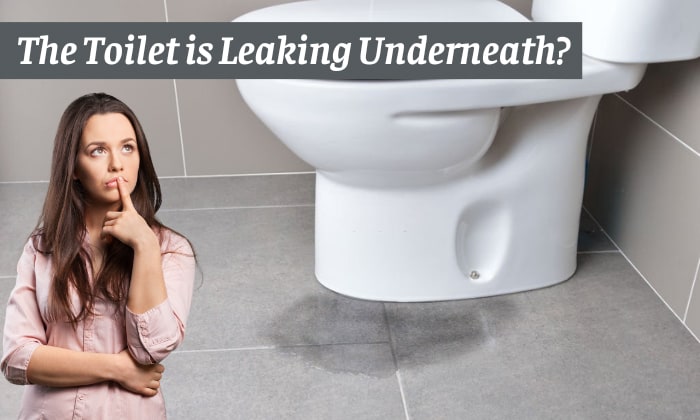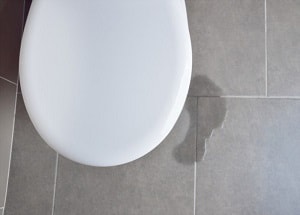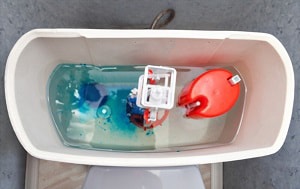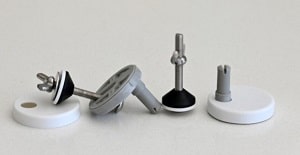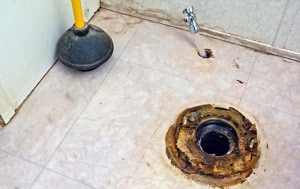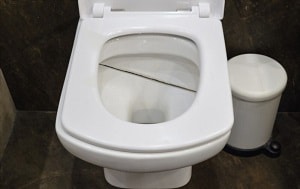It’s not hard to notice when a toilet is leaking. When there are signs of water seeping from the bowl of your toilet, you’ll have to identify the source of the problem before fixing it.
From this article, you will learn how to tell if your toilet is leaking underneath, why the problems occur, and how to mend them. A foul odor and water found near the base of the toilet are two indications that there is a leak underneath your toilet.
Table of Contents
How to Know if Your Toilet is Leaking Underneath
Listed below are the things you need to take note of to check toilet for leaks.
1. Water Condensation Around The Bowl
Water on the floor around the toilet bowl is the most typical sign that a toilet is leaking at base. The presence of visible puddles on the flooring of your bathroom, particularly close to the toilet, is frequently a strong indicator of such an issue.
Moreover, on various occasions, in addition to the water that is evident all over the surrounding area of the base, there can be sludge and sediment. This is another sign of moderate moisture around base of toilet.
2. Bad Stench
If a foul smell greets you when you enter the bathroom, be concerned because it means that there is a leak underneath the toilet.
When the bad stench persists even after thorough toilet cleaning, a leak from bottom of the toilet becomes even more of an obvious problem.
Additionally, the worst-case scenario is that the odor intensifies when it interacts with the moisture and sludge near the base of the toilet.
3. Dye Tab Testing
A toilet with leakage issues may occasionally run on its own. You may have become accustomed to this noise, but it’s not a good indication. There is a leak between the tank and the bowl if the toilet sometimes phantom flushes.
To test a toilet for leaks, you might need to perform a dye tab test using dye tablets or food coloring drops.
Place 1-2 tablets (or 10-15 food coloring drops) in the tank and wait for 35 minutes. Do not flush the toilet during this time. After 10-20 minutes, check to see if the bowl of your toilet has any dye – a sure sign of leakage.
Why Does A Toilet Leak Underneath And How To Fix It?
A toilet leaking from the bottom can occur for many causes. Listed below are the frequent ones.
1. Loose Bolts
The tee bolts are responsible for keeping your toilet tightly attached to the ground. When these bolts go loose, your toilet will become unstable and prone to wobbling.
When this occurs, the wax ring-created seal is broken, consequently resulting in water leaking out of your toilet base after flushing.
Follow these steps to mend it:
- Step 1: Have penetrating oil, pliers, and a wrench at your disposal.
- Step 2: Pour several drops of penetrating oil to the tee bolts and leave it as it is for about 15 minutes.
- Step 3: Grab the bolt’s top with a pair of pliers. Do not twist or spin it whatsoever. Instead, grab the pliers’ handle tightly to ensure the bolt stays in place.
- Step 4: Manually spin the bolt with the other hand.
- Step 5: Do not over-tighten. It’s preferable to first hand-tighten, then progressively tighten each nut one-quarter turn at a time until the toilet is stable.
2. Broken Wax Ring
A broken wax seal is responsible for stopping water from dripping onto the floor by closing a toilet to the drain. An unsteady bowl is another sign of a broken wax seal. Not repairing or installing a new wax seal can cause leaking at the flange.
Fixing it entails draining a toilet to take it apart, replacing the flange bolts, and installing a new wax seal with a silicone ring or a better seal. Finally, you’ll need to bolt the toilet firmly onto the floor and seal it with caulk.
3. Toilet Bowl Cracks
Bowl cracks can be the culprit behind your toilet leakage. Check the bowl for visible cracks.
Your plumber will probably replace the entire toilet if it is cracked. Although cracks can be fixed, a plumber won’t be able to advise on the best course of action unless they are actually seen.
4. Condensation Build-up
Another reason is that toilet condensation collects on the floor. In cold regions, the moisture in the air may condense around the water tank or toilet bowl. The droplets may then drip onto the floor, resulting in small puddles of water.
To mend the problem, dry out the bathroom air using a dehumidifier or a bathroom exhaust fan. A cost-saving alternative can be done by showering quickly to avoid humidity buildup.
Another alternative is to procure an anti-sweat valve, which increases the temperature of the water in a toilet to prevent condensation.
5. Loose Water Supply Line
A loose water supply means that water can drip from it continually. At the intersection where the supply line meets the tank, ensure that the rubber seal and nut are not loose.
- Step 1: Try to find if there’s any visible gap in the supply pipe. If this is not possible, rely on your sense of touch.
- Step 2: Pull the flush lever until the tank is completely empty
- Step 3: Place a bucket or towel underneath the pipe to catch any remaining water that may drip down.
- Step 4: Screw tight the nuts on two ends of the pipe by hand. Then twist the nuts ¼ of the way with a wrench to make sure the supply line is tightened.
- Step 5: If there is any hole in the pipe, seal it shut with water-resistant tape. My go-to recommendation is a plumber’s tape.
Read more: Ways to adjust water level in a toilet bowl.
FAQs
Can the toilet leak without me knowing?
Yes, there are times when your toilet leak without you knowing. If you noticed that there’s an unexplained increase in your water bill, you may want to inspect your toilet first as this could be a possible sign of leakage.
How do I know if my toilet is leaking from the base?
There are three signs you can use to determine if your toilet leaking under floor – the unusual noise, flooded areas around the toilet bowl, and the base feeling spongy.
How do you check for toilet leaks?
Remove the toilet tank cover and add a few drops of food coloring to check for leaks. Instead of flushing the toilet, wait 10-20 minutes. Check the water in the bowl after that. You can tell you have a leak if the food coloring has dripped into the bowl.
Why does my toilet leak when flushed only?
Usually, your toilet leaking when flushed only is caused by some factors. These include loosened tank bolts, worn wax rings, damaged closet flanges, and loose flush valves. Finding the leak’s source is the first step in solving the issue.
What to do when the upstairs toilet is leaking?
- Immediately turn off the electricity at the electrical service panel or breaker box.
- Halt the flow of water to the leak if it is safe to enter the bathroom.
- Once the water is successfully stopped flowing, contact a licensed plumber to take care of the leak.
Read more: Ways to turn off water to toilet with no valve.
Conclusion
Now that you have learned how to tell if your toilet is leaking underneath, you’ll be able to sense danger and prepare precautionary measures for your toilet. Checking the toilet for leaks is a practice that should be done consistently at least once every six months.
Calling a qualified plumber is the simplest approach to mending a leaking toilet, and you may end up doing that. However, if you don’t mind doing a little DIY project, the mending might be quick and inexpensive.

I’m Paulk Webb, and I work as a writer for Saveourwaterrebates. I’m happy to put in the time and effort to conduct market research to identify the most pressing issues faced by households concerning their plumbing. Feel free to check out our guides to get the most informed recommendations for how to solve your problems.


